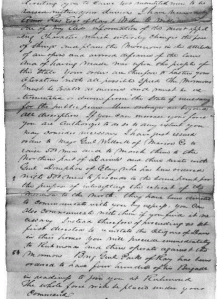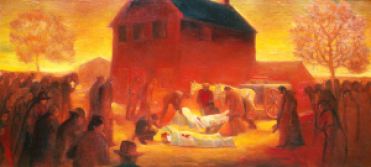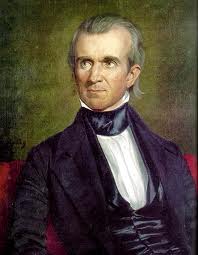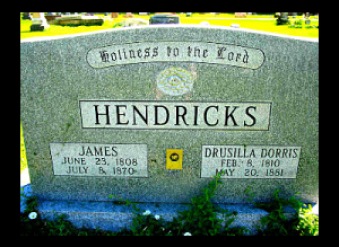 As we have read the beginning chapters of the New Testament, I am inspired by the attitude that Mary exhibited when she is told that she is to be the mother of the Son of God. We can only imagine the way that others would have judged her, being in a situation that to many would place her in a bad light. I have pondered over the challenges she must have faced in her day. She lived to see the Savior crucified, it is reasonable to suppose that she had many challenges that both stretched her resolve and strengthened her faith in God.
As we have read the beginning chapters of the New Testament, I am inspired by the attitude that Mary exhibited when she is told that she is to be the mother of the Son of God. We can only imagine the way that others would have judged her, being in a situation that to many would place her in a bad light. I have pondered over the challenges she must have faced in her day. She lived to see the Savior crucified, it is reasonable to suppose that she had many challenges that both stretched her resolve and strengthened her faith in God.
 I came across a wonderful book entitled “Divine Signatures: The Confirming Hand of God” by Gerald Lund. In this book Elder Lund shares examples of how the Lord has made Himself manifest in the lives of people who face trying circumstances. One such story comes from the life of Drusilla Hendricks, found on pages 112-121 of this book. The story of her faith is inspiring. I believe that as we learn of the ways the Lord confirms the faith of others that we gain the courage to make righteous choices in our own personal struggles.
I came across a wonderful book entitled “Divine Signatures: The Confirming Hand of God” by Gerald Lund. In this book Elder Lund shares examples of how the Lord has made Himself manifest in the lives of people who face trying circumstances. One such story comes from the life of Drusilla Hendricks, found on pages 112-121 of this book. The story of her faith is inspiring. I believe that as we learn of the ways the Lord confirms the faith of others that we gain the courage to make righteous choices in our own personal struggles.
The life of Drusilla Dorris Hendricks is an example of how the Lord gives us blessings so that we know of His love and desires for us.
Don’t Get Shot in the Back
As war and mobocracy erupted in western Missouri late in 1838, the Saints were once again in grave danger. One night, the Missouri militia, which was often little more than an organized and authorized mob, began raiding some of the outlying Mormon settlements. On October 24, they raided one homestead, burning haystacks and shooting livestock. Then they took three men prison and vowed they were taking them to be executed. On hearing the news, Joseph Smith called out the militia in Far West. Led by David W. Patten, senior member of the Quorum of the Twelve, seventy-five men set out in pursuit.
One of the men who answered Joseph’s call was James Hendricks, a native of Kentucky. In 1827 James had married a young girl named Drusilla Dorris, who lived just across the border in Tennessee. They joined the church in 1835, in spite of strenuous objections from their families. In the spring of 1836, they moved with their family to Missouri, settling first in Clay County, and then eventually moving north to Caldwell County, where they lived in a dugout. For a time they and their fellow Latter-day Saints lived in peace.
But as October drew to a close that all changed. James was a member of the Mormon militia and so was called out in the night to help rescue the three men. Drusilla later wrote of that night:
We had prayed and went to bed and fell asleep. I dreamed that something had befallen him and I was gathering him in my arms when Brother Charles C. Rich (one of the captains of the militia) called at the door for him and told him what he wanted. They had word that the mob was on Crooked River ten miles south of us and was a strong band. He said they had two (it was actually three) of our brethren as prisoners nad were doing all the damage that lay in their power… He bid me goodnight and got on his horse, and I took his gun from the rack and handed it to him and said, “Don’t get shot in the back.”
The Battle of Crooked River
Two companies of the brethren, under the command of Charles C. Rich and David W. Patten, rode all night. As dawn came, they approached a ford on the Crooked River. But they were traveling eastward, so the light was in their eyes, and they didn’t see that the Missourians were camped in the brush on the other side. As the Mormons started across the ford, one of the guards saw them coming and opened fire, shouting at his comrades that they were under attack. An intense firefight followed. Silhouetted by the dawn light, the Mormons were easy targets.
One man was shot in the face and killed instantly. David Patten took a ball in the stomach and would die later that day, becoming the first apostle to be martyred in this dispensation. James Hendricks turned when the firing erupted and started back across the river to find cover. Tragically, Drusilla’s premonition proved correct. A bullet hit him in the back of the neck and he fell into the water, paralyzed.
Drusilla’s account continues:
I had got used to his going, so went to bed and went to sleep. Just about the time he was shot I was aroused from my sleep suddenly, and I thought the yard was full of men and they were shooting. I was on my feet before I knew what I was doing. I went to the window at the back of the house but all was still. I was afraid to open the door. I could hear nothing, so I ventured to open the door. It was getting light enough, so I could see very little. I went out and around the house and found there was no one there. Then I was worse scared than ever, for I thought it was a token to me that they had had a battle.
A short time later, Drusilla learned that James had been wounded and was in a house about four miles away.
My husband lay within three feet of Brother Patten and I spoke to him. He could speak but could not move any more than if he were dead. I tried to get him to move his feet but he could not. This was Thursday, October 25, 1838… My husband was shot in the neck where it cut off all feeling to the body. It is of no use for me to try and tell how I felt, for that is impossible, but I could not have shed a tear if all had been dead before me. I went to work to try and get my husband warm but could not. I rubbed and steamed him but could get no circulation. He was dead from the neck down.
I Strained Every Nerve

As if the tragedy that had befallen her husband was not enough, now the full fury of the Missourians fell upon the Saints. Haun’s Mill, the fall of Far West, and the arrest of Joseph and other leaders all occurred a few days later. The Saints were told to leave the state as quickly as possible or face death. Drusilla’s oldest boy was eight at that time, and she had four other children, including a nursing infant. All of that, and with her husband paralyzed from the neck down.
Through the dark days ahead, numerous prayers were offered and two blessings given to James. Joseph Smith Sr. blessed James to the point where he could eventually stand on his feet and walk a few steps if he was helped by others. That was a miracle, and Drusilla expressed gratitude for it, but it didn’t changer her situation a great deal. At one point during those terrible months, James became very ill. Drusilla said, “I had to lift him at least fifty times a day, and in doing so I had to strain every nerve.”
War With Mexico
Along with the rest of the Saints, Drusilla and her family eventually came to Nauvoo, and they entered into a time of peace. Life improved somewhat, but James was still unable to provide for his family. Life for Drusilla was very difficult. Yet in spite of these grinding challenges, she never lost her faith. Looking back many years later, she talked of the myriad of things she did to try to support her family- she chinked and plastered her own chimney, planted a garden, sold things to the crowds on public holidays, took in washing for others. Then she added this: “I paid a good deal of tithing by making gloves and mittens.”

The time of peace was short-lived. In 1844, the Prophet Joseph and his brother Hyrum were martyred in Carthage Jail. Within another year, the enemies were on the prowl again, threatening the Saints if they didn’t leave the state the following spring. The first wagons crossed the Mississippi River on February 4, 1846, and headed west across Iowa. The main body reached Council Bluffs, Iowa Territory, in mid-June.
By now, Drusilla’s oldest son, William, was sixteen years old. He was a great blessing to his mother. Though she had a daughter two years older than William, now she had a man to help take the place of her crippled husband. They secured an outfit, put James in a bed in the back of their wagon, and started west. When the y arrived in Council Bluffs, Iowa, in mid to lat June of 1846, Drusilla had no way of knowing that another severe test of her faith was about to descend upon her.

In 1845, President James K. Polk decided to accept the petitions of a large group of Texans and formally annexed the area known as Texas into the United States. Most of Texas lay in Mexican territory, and Mexico was understandably angered by Polk’s decision. Relationships between the two nations deteriorated to the point that on May 12, 1846, Congress declared war on Mexico.
During the same time, the Church had been petitioning Congress for assistance in their move west, hoping to build forts along the Oregon Trail. The war with Mexico created a different kind of opportunity. On July 1, 1856, Captain James Allen of the U.S. Army came to Council Bluffs with the request that the Mormons furnish five hundred volunteers to march to California and claim that territory of the United States as well.
In spite of the lack of support the Church had received in previous years from the federal government, Brigham Young saw several distinct advantages to this request, and on July 3, he signed an agreement and issued a call for volunteers to join what would become the Mormon Battalion.
Are You Afraid to Trust the God of Israel?
When young William Hendricks heard the news, he immediately determined to go. What an exciting adventure for a young man who would not turn seventeen until November of that year. But when he went to his mother, she adamantly refused to consider it even for a moment. She later wrote of her agony at that time:
One would say to me, Is William going? I answered, no… Why, they said, they would not have their son or husband stay for anything. Then I would say, a burned child dreads the fire.
In other words, she had already seen her husband go off to battle in the Lord’s cause, and he had returned paralyzed from the neck down. She wasn’t about to send her son to war and risk the same thing.
But it was more than that. She still had to take her family, including her handicapped husband, across a thousand miles of wilderness and make a new home in the Rocky Mountains. We can only imagine her thoughts at that time. Surely the Lord did not expect her to do such a thing without the only man she had to help her? Hadn’t she already done enough, sacrificed enough? While her logic may have been good, it didn’t work. She noted that even in her adamancy she felt doubts about her decision.
“The whispering of the Spirit would say to me: ‘Are you afraid to trust the God of Israel? Has He not been with you in all your trials? Has He not provided for your wants?’ Then I would have to acknowledge the hand of God in all His goodness to me.”
This is astonishing in so many ways. Surely the Spirit wasn’t chastising her for a lack of faith? She, who had already stood steadfast through eight years of trial and challenge? Why didn’t she blurt out, “But, Lord, have you forgotten about my husband? Have you forgotten what I have already been through? Would you really have me cross the plains on my own?” Instead, she acknowledges the goodness of God and His hand in her life. What an amazing woman!
The volunteers were mustered in on 16 July. Before they marched away to California, the Saints treated them to a farewell ball… Drusilla … attended the dance with her son William… But William wanted to go with the battalion, and Drusilla struggled to decide what to do. The next morning she watched him go about his work.
“I got ready to get breakfast,” she wrote, “and when I stepped up on the wagon tongue to get my flour I was asked by the same spirit that had spoken to me before, If I did not want the greatest glory and I answered with my natural voice, Yes I did. Then how can you get it without making the greatest sacrifice, said the voice. I answered Lord, what lack I yet? Let your son go in the Battalion, said the voice.
I said it is too late, they are to be marched off this morning. That spirit then left me with the heart ache. I got breakfast and called the girls and their Father to come to the tent for prayers. William came wet with dew from the grass and we sat down around the board and my husband commenced asking the blessing on our food, when Thomas Williams came shouting at the tope of his voice, saying “Turn out men, Turn out, for we do not wish to press you but we lack some men yet in the Battalion.” William raised his eyes and looked me in the face. I knew then that he would go as well as I know now that he has been.
With heavy heart, Drusilla told her son that he had her permission to go. What an amazing example of a softened heart. and what happened immediately afterward was a direct result of that submission to the Lord’s will:
I went to milk the cows… I thought the cows would be shelter for me and I knelt down and told the Lord if he wanted my child to take him, only spare his life and let him be restored to me and to the bosom of the church. I felt it was all I could do. Then the voice that talked with me in the morning answered me saying, It shall be done unto you as it was unto Abraham when he offered Isaac on the altar. I don’t know whether I milked or not for I felt the Lord had spoken to me.
So how did the story end for Drusilla? Her earnest prayer that her son’s life be spared was answered. William survived the long march to California and rejoined his family after they had reached the Salt Lake Valley. Together they went on to help settle Cache Valley in northern Utah.
 James survived the trek to Salt Lake and became the first bishop in the Nineteenth Ward in Salt Lake, where Drusilla also became the Relief Society president. He died eleven years before Drusilla, who passed away at the age of seventy-one. In her final years she wrote:
James survived the trek to Salt Lake and became the first bishop in the Nineteenth Ward in Salt Lake, where Drusilla also became the Relief Society president. He died eleven years before Drusilla, who passed away at the age of seventy-one. In her final years she wrote:
The gospel is true. I have rejoiced in it through all my trials for the Spirit of the Lord has buoyed me up or I should have failed.
Brigham Young spoke highly of such women as Drusilla. “‘If the women did not accomplish as much as the men did,’ he said, it was because the women ‘had no wives to help them.'” 1
Notes
1.Leonard J. Arrington and Susan Arrington Madsen, Sunbonnet Sisters: True Stories of Mormon Women and Frontier Life, Salt Lake City: Bookcraft, 1984, p. 32.

I am the fourth great granddaughter of Drusilla D Hendricks. Her youngest son was named by the prophet Joseph Smith. He came to see their family and she asked him if he would bless their son. He gave the son his own name and that is the son our line goes through-Jospeh Smith Hendricks. She is truly an inspiration in our lives. Do you mind if make a copy of this post and link it to Drusilla in our tree on Ancestry.com?
It would be an honor. She is an inspiration!
I am also a fourth Great Granddaughter through Joseph Smith Hendricks 🙂 .
Drusilla is a great hero of mine! Thanks for sharing!
Elder Hendricks here. I know not my direct line, but it was great to read this. Such strength is through this line of family. Blessings come to the obedient.
Drusilla is my first cousin 4X removed; she is one of our heros of faith, strength, sacrifice, and courage for our family to honor. Below is my relationship to her:
Drusilla Dorris (1810 – 1881)
is my 1st cousin 4x removed
William Gibbs Dorris (1766 – 1832)
father of Drusilla Dorris
Martha Hughs (Hues, Huel) (1738 – )
mother of William Gibbs Dorris
Samuel Jr. Dorris (1770 – 1837)
son of Martha Hughs (Hues, Huel)
Josiah Frost Dorris (1808 – 1883)
son of Samuel Jr. Dorris
Elisha Allen Dorris (1827 – 1913)
son of Josiah Frost Dorris
Harvey Walton Dorris (1879 – 1952)
son of Elisha Allen Dorris
Reynold Bridgewater Dorris (1912 – 1989)
son of Harvey Walton Dorris
Joe Miller Dorris
I am the son of Reynold Bridgewater Dorris –
I love her story. She is an absolute inspiration!
Drusilla is my third great-grandmother through William Doris. Ever since I read her story years ago she has always been an inspiration to me. Her faith never faltered through all her trials. When I get to the other side she is one of the first people I want to meet!!
She is an inspiration to me!
I am the 5th great grandson through Joseph Smith Hendricks Sr. – Joseph Smith Hendricks jr-Harriet Lorane H Smith- Orva Winnegar ManleyJeppeson- Vera Jeanne Manley Babcock- Fount Thomas Babcock jr (Tommy Babcock aka me) For many years I had heard the stories of both James and Drusilla in Seminary, church, and General Conferences, but little did I know that she was literally my grandmother 5 times removed. We had always known that our family had a close connection to Joseph Smith, as my great uncle, whom I knew growing up. was named Joseph Smith Winegar, but I didn’t realize that that it was due to our ancestor being the story of blessing the baby as the camped along the swamps.It was only later, after serving a mission, that I was able to learn of our connection to several stories that I had used while teaching on my mission. My parents were serving as missionaries in the Independance Missouri mission, when a historian informed them of my mother’s close relation to Drucilla, and then took them to the sites where many of those stories took place. We have a Hendricks family history book, that has many more amazing stories about the Hendricks church history, and the amazing things that James Hendricks father was able to accomplish during the early years of our country. He too, was a war hero, and was the one that made it possible for the Mormons to purchase the land which the Smith and Hendricks homes were on, when the battle of crooked river took place. He was very respected and bought the land when nobody else would sell to the Mormons, and then handed it over to his son to use as the place for the early converts from Europe to come join with the other members. They worked the land for free to provide food for those members that had left everything to join the church, and as rent to Drusilla and James to repay his father. The Smith cabin was built on the opposite side of the property, and was where they took those injured during the battle. While Drusilla came to aid James, the mobs came and killed all the lifestock, looted and burned their home, and salted the fields. They sacrificed everything, but never lost their testimonies. Her journal is one of my favorite pieces of LDS history, as it also explains all about their life before joining and the sickness that she had fought through as a teen. She is a true inspiration!